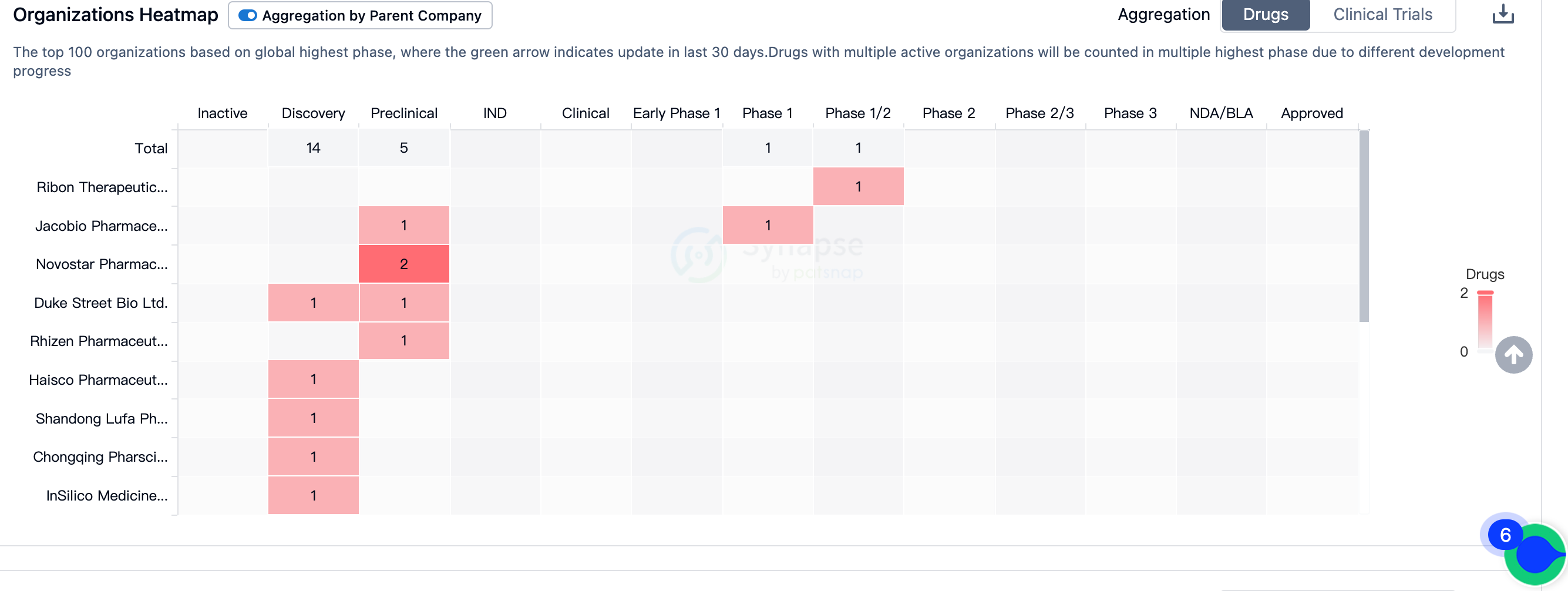Overview of the Development Progress of PARP-7 Drug Target
PARP7 functions by catalyzing the transfer of a single ADP-ribose unit onto substrates, altering their functionality. As a negative regulator of nucleic acid sensing in tumor cells, inhibiting PARP7 has demonstrated remarkable effects in restoring the response of nucleic acids to the type I interferon (IFN) signaling pathway in tumor models.
This restoration of signaling not only directly inhibits cell proliferation but also activates the immune system, contributing to tumor regression. The preclinical proof-of-concept (POC) and the confirmed druggability of this pathway further enhance the attractiveness of PARP7 as a therapeutic target.
Among the pioneers in recognizing the pharmaceutical potential of PARP7 inhibitors is AZ, a leading company in this field. Understanding and targeting PARP7 can open new avenues for effective cancer treatments.
According to the statistics from Synapse, there are currently 20 drugs targeting PARP7 in the developmental stage, covering indications in 8 disease areas. The competition among 19 research institutions in this field is intense. Small molecules are the predominant type of drugs being developed, with a high number of 216 patents and 191 scientific publications. These numbers highlight the research intensity and potential value of PARP7-targeted drugs.
With a significant number of ongoing developments, it is evident that PARP7 is a promising drug target with considerable interest in the scientific community and industry. Exploring the therapeutic potential of PARP7 inhibition could lead to innovative treatments across various disease domains. If you are looking for effective drugs targeting PARP7, the ongoing research and development efforts offer promising prospects.
PARP7 Competitive Landscape
When conducting a search for PARP7 in Synapse, it is evident that numerous domestic companies in China have actively participated in the development of PARP7 inhibitors. Some of these companies include Jacobio、Novostar、Haisco、Shandong Lufa、Chongqing Pharscin、WuXi AppTec、Inventisbio、Hangzhou Yingchuang, among others. Notably, Ribon's RBN-2397 has progressed to Phase 1/2 clinical trials, Jasco has submitted a clinical application for JAB-26766, and Novostar has initiated preclinical research on two PARP-7 inhibitors, NSP-5020 and NSP-5033.
Key Drug: RBN2397
RBN-2397 is a drug developed by Ribon Therapeutics. It was discovered through high-throughput screening (HTS) as a potential compound and further optimized based on its interaction with the key binding pocket region of nicotinamide adenine dinucleotide (NAD+).
By inhibiting PARP7 in tumor cells, RBN-2397 directly suppresses cell proliferation and restores type I interferon signaling, thereby activating innate or adaptive anti-tumor immune responses.
Currently, RBN-2397 is in the dose escalation phase, involving 50 patients. Dose regimens and relative bioavailability have been evaluated through administration ranging from 25 mg to 500 mg twice daily (BID). The most common tumor types enrolled in the study were breast cancer (n=8), lung cancer (n=7), and colorectal cancer (n=5). The recommended phase 2 dose (RP2D) is 200 mg BID, administered continuously with oral tablets.
In the dose expansion phase, 53 patients have been enrolled, including small cell lung cancer (22 cases), head and neck squamous cell carcinoma (17 cases), and hormone receptor-positive breast cancer (14 cases). RBN-2397 has demonstrated good tolerability at the RP2D and exhibited both biological and anti-tumor activities based on the observed exposure.

The development of RBN-2397 represents a significant advancement in the field of PARP7 inhibitors. Its promising pharmacological profile and potential efficacy in various tumor types make it a subject of great interest among researchers, healthcare professionals, and the pharmaceutical industry. By targeting PARP7, RBN-2397 holds the potential to offer a novel therapeutic approach in cancer treatment and has the possibility to address unmet medical needs in patients.
Staying informed about the ongoing clinical trials and updates related to RBN-2397 is crucial for researchers, medical practitioners, and stakeholders in the field. This information can aid in identifying potential collaborations, investment opportunities, and the future market landscape. As the development of RBN-2397 progresses, continued monitoring of its efficacy and safety profiles will contribute to the advancement of precision medicine and personalized treatment strategies for cancer patients.
RBN-2397 demonstrates excellent safety and tolerability, as evidenced by the following observations. Only five patients (4.9%) experienced treatment-related acute lung injury, and treatment was discontinued due to adverse events in 28 patients (27.2%) and 12 patients (11.7%), respectively. Compared to approved PARP1/2 inhibitors, RBN-2397 exhibits a lower incidence of hematological toxicity.
Overall, RBN-2397 shows good tolerability, with most adverse events being mild to moderate. Preliminary evidence of anti-tumor activity has been observed during dose escalation and expansion cohort studies. In the dose escalation phase, one patient with hormone receptor-positive breast cancer achieved partial response (PR), and 13 patients had disease stabilization (SD) with a clinical benefit duration exceeding four months.
In the dose expansion phase, one patient with head and neck squamous cell carcinoma (HNSCC) achieved a response, and four patients had disease stabilization with a clinical benefit duration exceeding four months. Baseline biopsies across all evaluations revealed expression of PARP7, with higher expression levels observed in tumor cells compared to stromal cells.
Increased expression of CD8+ T cells and/or granzyme B was observed in expanded cohort patients across multiple tumor types, indicating the induction of adaptive immune responses following RBN-2397 treatment. RBN-2397 can activate the tumor-specific IFN pathway and enhance immune cell infiltration into the tumor site, providing evidence for the induction of adaptive immune responses.
These data validate the role of PARP7 as a novel target for anti-cancer therapy and confirm the mechanism of action of RBN-2397. These results support the ongoing clinical trials investigating the combination of RBN-2397 with pembrolizumab (NCT05127590) and nivolumab (jRCT2031210373).

References
1.https://www.futuremarketinsights.com/reports/parp-inhibitors-market.
2. Heike Keilhack, et al. PARP7 negatively regulates the type I interferon response in cancer cells and its inhibition triggers antitumor immunity. https://doi-org.libproxy1.nus.edu.sg/10.1016/j.ccell.2021.06.018.
3.Melissa Johnson, et al. First-in-Class First-in-Human Phase 1 Trial of RBN-2397 in Patients with Advanced Solid Tumors Validates PARP7 as a Novel Anticancer Therapeutic Target.2023,ESMO,TAT.
4.Yun genxu, et al. Discovery of the Potent and Highly Selective PARP7 Inhibitor as a Novel Immunotherapeutic Agent for Tumors.J. Med. Chem. 2023, 66, 473−490.
5.Oriana Tabarrini, et al. Medicinal Chemistry Perspective on Targeting Mono-ADPRibosylating PARPs with Small Molecules.J. Med. Chem. 2022, 65, 7532−7560.




